Lift Off Time/Launch Window | NET March 3, 2021 – TBD |
|---|---|
Mission Name | Medium Altitude Test Flight |
Launch Provider | SpaceX |
Customer | SpaceX |
Rocket | Starship SN10-1 |
Launch Location | Test Stand A, Boca Chica Launch Site, Boca Chica, Texas, United States |
Will they be attempting to recover the stage? | Yes |
Where will the stage land? | SN10 will attempt a propulsive landing on the landing pad in Boca Chica, Texas |
Will they be attempting to recover the fairings? | The fairings — or more accurately, the nosecone — are integrated into the vehicle and will be recovered with it |
How’s the weather looking? | TBD |
This will be the: | – 1st launch of SN10 – 5th flight of a Starship prototype (7th if you count Starhopper’s two hops; 8th if you also count Starhopper’s short tethered hop) – 3rd flight of a Starship prototype with three engines and aerodynamic control surfaces |
Where to watch | Official livestream Tim Dodd, the Everyday Astronaut, will be streaming; come ask questions and join the conversation live! Live updates on the lead-up to SN10’s flight. |
What’s all this mean?
Starship SN10 will be attempting a medium altitude test flight (~10 km). It will lift off from Boca Chica, Texas under the power of three Raptor engines. At apogee, it will flip into a horizontal configuration for descent. Prior to landing, it will ignite three of its Raptor engines to initiate the landing flip before shutting one down. SN10 will attempt a propulsive landing on the landing pad, potentially becoming the first Starship prototype to successfully do so.
What is Starship?
Starship/Super Heavy is SpaceX’s next-generation super heavy-lift reusable launch vehicle. The first stage, known as Super Heavy, will produce 71.2 MN of thrust, while the Saturn V, the most powerful rocket ever flown, produced 34 MN of thrust. This will make it the most powerful rocket ever made. When it’s operational, Starship will liftoff from either Boca Chica, Texas; Cape Canaveral, Florida; or an offshore launch platform.
After stage separation, the Super Heavy booster will perform a boost-back burn and a re-entry burn to slow itself down enough to return to launch site. The booster will perform a fourth and final burn to land either on or near the launch pad.
After the completion of its mission, Starship will perform a deorbit burn then reorientate to re-enter heatshield-first. Reentry will bleed off most of the vehicle’s velocity. Just prior to landing, Starship will reorientate itself again to perform a propulsive vertical landing. Starship and Super Heavy will then be restacked, refueled, then launched again.
The future of Starship
Starship is SpaceX’s plan to colonize Mars and dramatically bring down the cost of space travel. With an estimated eventual cost of $2 million per flight, Starship will be one of the cheapest orbital rockets ever, especially on a cost-per-kilogram basis. Starship will be able to carry 100 tonnes to just about anywhere, due to orbital refueling.
It’s designed to revolutionize travel not only in space, but on Earth as well. If Starship’s goals for airplane-like safety and reliability pan out, it could be used for suborbital point-to-point Earth travel. With a relatively low price tag, a fairly average person could be anywhere in the world in less than an hour.
Starship variants
There will be several Starship variants, including a cargo variant with a clam shell-like opening to deploy satellites, a crewed variant with life support systems and crew habitation areas in place of a cargo bay, and a lunar variant without flaps and with additional thrusters.
Since Starship is the second stage of the rocket and not just a spaceship, it will have to use most of its fuel to insert itself into orbit. To enable Starship to carry out deep-space missions with 100-tonne payloads, SpaceX will also have a tanker Starship variant. This variant will be similar in appearance to the cargo version, but will have extended fuel tanks instead of a payload bay. This Starship will dock by the engine bay with another Starship carrying either crew or cargo in low Earth orbit (LEO) and refuel it. It may take several rendezvous and refuellings in LEO before a Starship has enough fuel to continue its journey deeper into space.
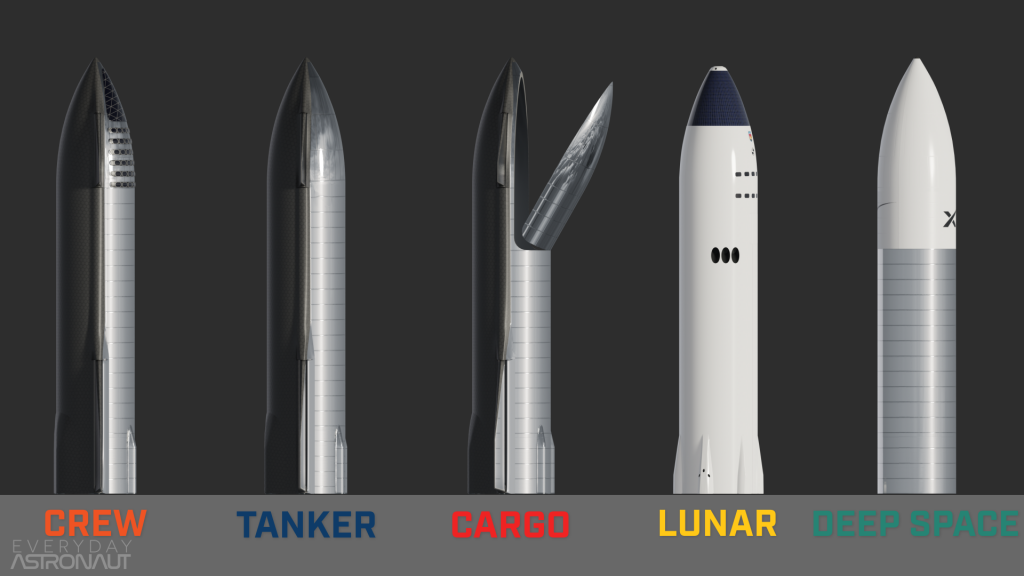
Raptor
Raptor is SpaceX’s newest rocket engine. It’s the only full-flow staged combustion cycle engine to have ever flown. It’s able to produce about 2,300 kN (500,000 lbs) of thrust, making it twice as powerful as SpaceX’s workhorse Merlin engine.
The fact that Raptor is a full-flow staged combustion cycle (FFSCC) engine makes it unique among rocket engines. In a closed cycle rocket engine (which Raptor is), the fuel used to spin up the turbines is directed into the combustion chamber rather than being ejected out of a preburner. This means all fuel fed into the engine is combusted, resulting in a more efficient engine. Additionally, all of the fuel in the Raptor engine is burnt in the preburners and sent to the combustion chamber as gas, which allows Raptor to achieve higher pressures, and in turn, higher thrust and specific impulse.
History of Starship
MCT and ITS
The history of SpaceX’s plans for a massive, reusable Mars rocket stretches back to at least 2012. Mars Colonial Transporter (MCT) was the name of the first proposed super heavy-lift launch vehicle. MCT’s design changed many times over the years. In 2016, it became the Interplanetary Transport System (ITS).
ITS was to be a reusable two-stage carbon fiber launch vehicle, 122 meters (400 feet) tall and 12 meters (39 feet) wide. It would be able to carry over 500 tonnes of payload into low-Earth orbit in an expendable configuration, and 300 tonnes in a reusable configuration. Powered by 42 Raptor engines, the first stage would be able to produce 130 MN of thrust, several times the 36 MN of thrust produced by the Saturn V — the most powerful rocket ever successfully flown. The ITS upper stage had three large retractable legs and 9 Raptor engines: 3 sea level and 6 vacuum.
In 2016, SpaceX successfully cryogenically tested a 12 meter carbon composite tank to destruction.

BFR
A major redesign was announced at the International Astronautical Congress in 2017. Big Falcon Rocket (BFR) became the temporary new name of SpaceX’s interplanetary spacecraft. It was downsized to 9 meters (30 feet) in diameter for ease of production. The number of Raptor engines on the second stage was decreased to 7: 3 sea level and 4 vacuum. A delta wing was introduced to the vehicle for control during atmospheric entry. SpaceX began building a prototype vehicle at the Port of Los Angeles in 2018, with test flights scheduled to begin the following year, but it was later scrapped.
Starship
The vehicle changed again in September of 2018. The first stage became known as Super Heavy and the second stage became known as Starship. The design changed significantly; two canards were added to the forward section of the vehicle and three rear fins were added to the aft section in place of the single delta wing found on the BFR. Both of the canards as well as two of the rear fins were able to actuate to control the vehicle during atmospheric entry. All three of the rear fins doubled as landing legs.
It was also announced that Japanese billionaire Yusaku Maezawa would partially fund Starship’s development as part of the #dearMoon project. Yusaku, as well as several artists and crew members, are supposed to take a trip on Starship around the far side of the moon no earlier than 2023. The goal of the trip is to inspire the artists to create work that will inspire other people back on Earth.
Stainless steel
In December of 2018, it was announced that Starship had switched from being made out of carbon fiber to being made out of stainless steel. The 301 stainless steel alloy SpaceX was using was not only significantly cheaper and easier to prototype with than carbon fiber, but was also able to withstand extreme temperatures much better. The steel actually gets stronger at cryogenic temperatures; it holds up well to high temperatures, as well. Because of that, the amount of heat shielding required on the windward side of the vehicle is significantly less than what would have been required for a carbon fiber vehicle.
The leeward side of the vehicle doesn’t require any sort of insulation because of stainless steel’s high melting point. Initially, the plan was to forgo heat shielding entirely and make use of transpirational cooling instead. This plan was scrapped several months later — though, certain areas may use transpirational cooling in the future.
Final design starts to solidify
Starship’s design changed slightly in May 2019. It went from having three rear fins to having two. This design gave Starship better control during atmospheric entry and was also lighter. There were now six landing legs around the perimeter of the vehicle instead of three landing legs built into the fins.
Prototype testing history
Starhopper
Construction of SpaceX’s first prototype vehicle, Starhopper, began in late 2018 in Boca Chica, Texas. SpaceX acquired property in Boca Chica in 2014, but the area sat largely dormant until 2018. Occasional dirt deliveries were the most interesting things happening in the four-year interim period. Starhopper was built outdoors with relatively primitive construction techniques. In Spring of 2019, Starhopper made the 2 mile trek from the construction site to the launch site.
Following several pressure tests, static fires, and shorter hops, Starhopper successfully hopped to an altitude of 150 meters and landed on a nearby landing pad. Though the engine had some issues, Starhopper stayed mostly in one piece. It remains at the launch site to this day, retrofitted as a water tower and camera mount.

Mk1 and Mk2
Starship prototypes Mk1 and Mk2 were built simultaneously with Starhopper’s test campaign. Mk1 was built in Boca Chica and Mk2 was built at a facility in Cocoa, Florida. The two teams at each of the facilities used different construction techniques and were required to share anything they learned along the way.
Final stacking of Mk1 occurred in September 2019, ahead of Elon Musk’s annual Starship presentation. For the first time, SpaceX had a full-scale prototype vehicle. Following the presentation, the nosecone was destacked from the tank section and Mk1 was rolled out to the launch site on October 30.
Mk1’s testing
Mk1’s test campaign began with a cryogenic pressure test on November 20. Cryo tests validate that a vehicle is able to withstand the extreme temperatures and pressures experienced when a vehicle is loaded with fuel by filling it with cryogenic liquids (in SpaceX’s case, liquid nitrogen). Poor weld quality caused Mk1’s tank to rupture, shooting the top bulkhead into the air and engulfing the vehicle in a cloud of nitrogen. Fortunately, Mk1’s failure wasn’t much of a setback as SpaceX wasn’t planning on ever flying the vehicle.
Mk2’s fate and the fate of the ‘Mk’ naming scheme
Work on Mk2 halted following Mk1’s failure. Weeks later, work on Mk4 — which was in the early stages of construction — was also halted. Mk2 sat dormant for months before it started being disassembled in July of 2020.
The ‘Mk’ naming scheme was retired in December 2019 in favor of an ‘SN’ nomenclature. ‘Mk3’ became known as ’SN1’.
Major changes
Mk1 and Mk2’s rudimentary construction process wasn’t going to work if SpaceX ever wanted to fly the vehicles. Mk1 was built out of many steel plates welded together, leading to a finished prototype that was heavy, had many weak points, and was expensive and time-consuming to construct. With lessons learned and a machine able to create steel rings out of a single roll of steel, SpaceX started to dramatically improve the construction process.
Early test tanks
January and February saw the testing of two scaled-down test tanks. These were the first tanks made out of the new single-piece steel rings and had improved bulkhead designs and welding techniques. They were each successfully tested to destruction at the launch site
SN1
Following the destruction of the two test tanks, SpaceX finished construction on their first full-sized prototype since Mk1: SN1.
SN1 had many improvements over Mk1, like single-piece rings, better weld quality, and improved bulkhead designs. It was rolled out to the launch site and began its test campaign with a cryogenic pressure test on February 28.
The thrust puck — the bottom bulkhead that serves as an attachment point for the Raptor engines — failed, and the vehicle was destroyed.
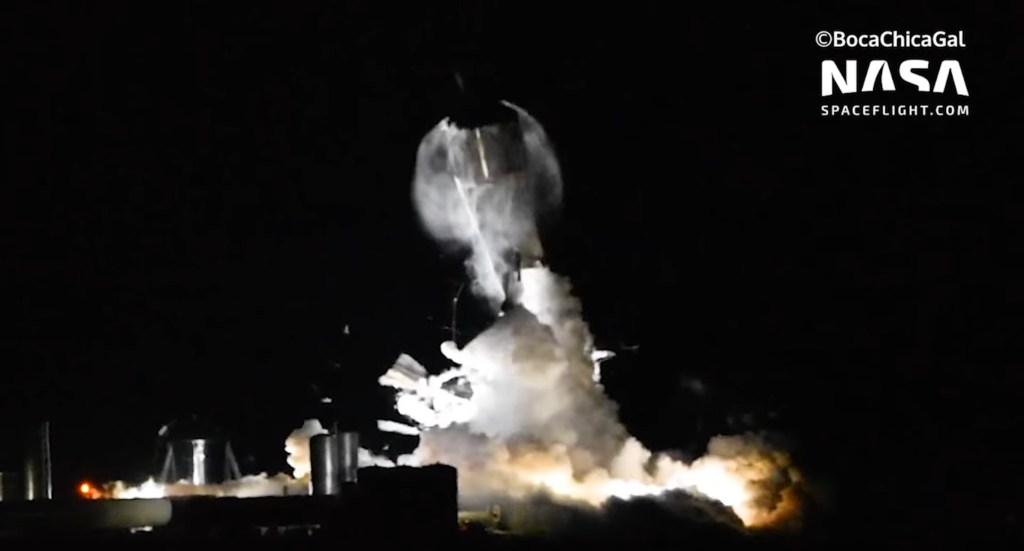
SN2 and new thrust puck
SpaceX redesigned the thrust puck and implemented it onto a scaled-down test tank: SN2. SN2 was subjected to a cryogenic pressure test and passed, validating the new thrust puck designed. SN2 was retired to the SpaceX scrapyard, where it has been repurposed as a water tower.
SN3
SN3 was the next full-sized prototype. It sported the new thrust puck and looked noticeably better than SN1. It was rolled out to the launch site and was subjected to a cryogenic pressure test on April 2.
SN3 failed its cryo test due a test configuration error. The ground support equipment (GSE) was unable to keep the two tanks at similar pressures, resulting in the oxygen tank crumpling under the weight of the methane tank above it. Somewhat fortunately, the failure wasn’t the fault of the vehicle, but rather, the GSE. No major design changes needed to be made to future prototypes to prevent this issue from occurring again.
SN4
SN4 was next, and it made use of the lower part of SN3’s skirt section. On April 26, SN4 became the first full-sized Starship prototype to pass cryogenic testing, reaching 4.9 bar. Raptor engine SN18 was installed the next day and SN4 static fired on May 4, feeding fuel from the two main fuel tanks. A second static fire occurred on May 7, this time feeding fuel from the main oxygen tank and the small methane header tank. The Raptor engine was removed on May 7, after the second static fire.
SN4 underwent a second cryogenic pressure test on May 9, and reached a pressure of 7.5 bar. The next day, Raptor engine SN20 was installed.
SN4 static fired on May 19, but knocked a methane line loose in the process. This caused a fire that scorched the vehicle and destroyed wiring, leaving SpaceX unable to depressurize the vehicle. Workers were unable to return to the pad for two days while the fuel slowly boiled off.
SpaceX was able to repair the vehicle and SN4 static fired again on May 29.
SN4 failure
SpaceX conducted a quick disconnect test in conjunction with the fourth static fire — the quick disconnect system disconnects the vehicle from the ground support equipment prior to a launch. The test caused a fuel leak, creating a large cloud around the vehicle. A hotspot in the engine skirt ignited the cloud and the vehicle exploded.
The explosion completely destroyed the vehicle as well as the stand it was on. SpaceX had already constructed a second test stand, so replacing the old one only took a matter of days.
SN5 and SN6
SN5 rolled out to the launch site on June 24 and passed a cryo test on June 30. It static fired a month later on July 30. On August 4, it successfully hopped to 150 meters and landed on the nearby landing pad.
To help SpaceX smooth out the Starship launch process, they also hopped SN6 to an altitude of 150 meters and landed it on the landing pad.
Both vehicles were disassembled in early 2021.

SN7, SN7.1, and SN7.2
SN7 was a scaled-down test tank tested between SN4 and SN5’s test campaigns. It was the first prototype to use the 304L stainless steel alloy — all of the previous prototypes used a 301 alloy. During its first cryo test, it sprung a leak at 7.61 bar. It was repaired and tested to destruction several days later. It failed at the weld line between the bottom bulkhead and the barrel section, and went several meters into the air along with its test stand.
SN7.1 was also a scaled-down test tank. It featured a new thrust puck design and was tested to destruction on September 23.
SN7.2 is currently at the launch site. Unlike all previous prototypes which used 4mm thick steel, SN7.2 is testing 3mm thick steel. It has already been subjected to two cryo tests and is awaiting its test to destruction.
SN8
SN8 was the first prototype (excluding Mk1) with a nosecone, aerodynamic control surfaces, an oxygen header tank, and three Raptor engines. It was also the first full-sized vehicle to use 304L stainless steel.
It launched to an altitude of 12.5km on December 9, 2020, and shut down its three Raptor engines at various intervals during ascent to decrease acceleration. At about 4 minutes and 40 seconds into flight, the single Raptor engine still burning initiated the flip maneuver before shutting down.
SN8 was able to control itself during descent using its four body flaps: two forward and two aft. It remained in a stable horizontal configuration throughout the entire ‘skydive’ phase of flight.
As SN8 approached the ground, two of its engines ignited one-by-one to initiate the landing flip and burn. It successfully transitioned back into a vertical position and the burn continued. The methane header tank lost pressure, however, so the engines weren’t receiving enough fuel to produce meaningful thrust. One of the engines shut down while the other one continued to burn, creating a green plume because the copper in the engine itself was combusting due to the absence of methane. SN8 impacted the ground at a high velocity and was destroyed.
Even though the vehicle was destroyed, the flight was considered a success. Being a test flight, it was expected that the vehicle might not survive. SN8 exceeded expectations by successfully demonstrating most of the major test objectives.
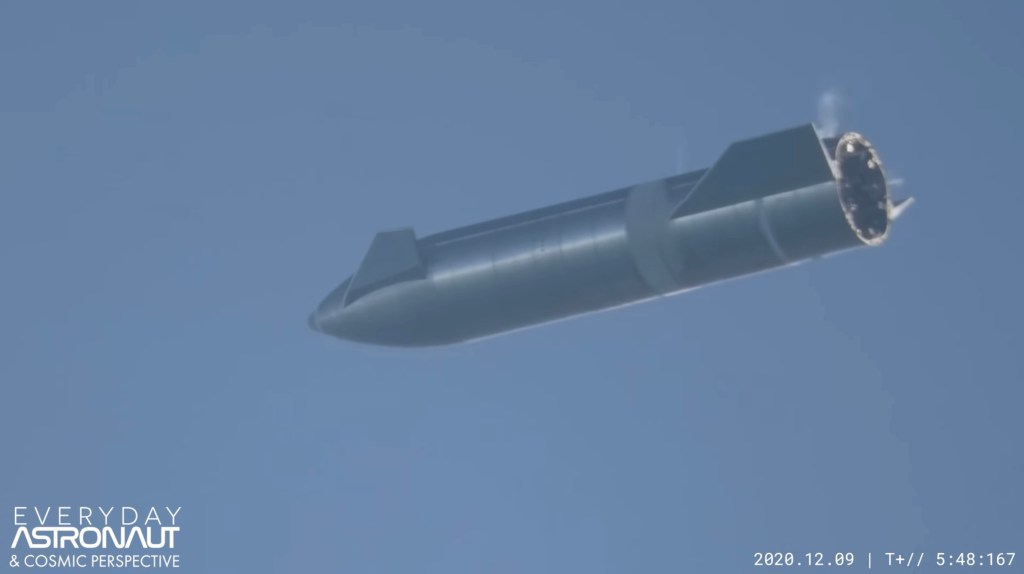
SN9
SN9 launched on February 2, 2021 to an altitude of 10 km. Its flight profile was nearly identical to SN8’s, just with a lower apogee.
SN9’s flight was successful up until the landing burn. It attempted to relight two of the Raptor engines, but only one properly ignited. Because of that, the vehicle was unable to slow down and transition into a vertical orientation, so it crashed onto the landing pad at a high velocity.
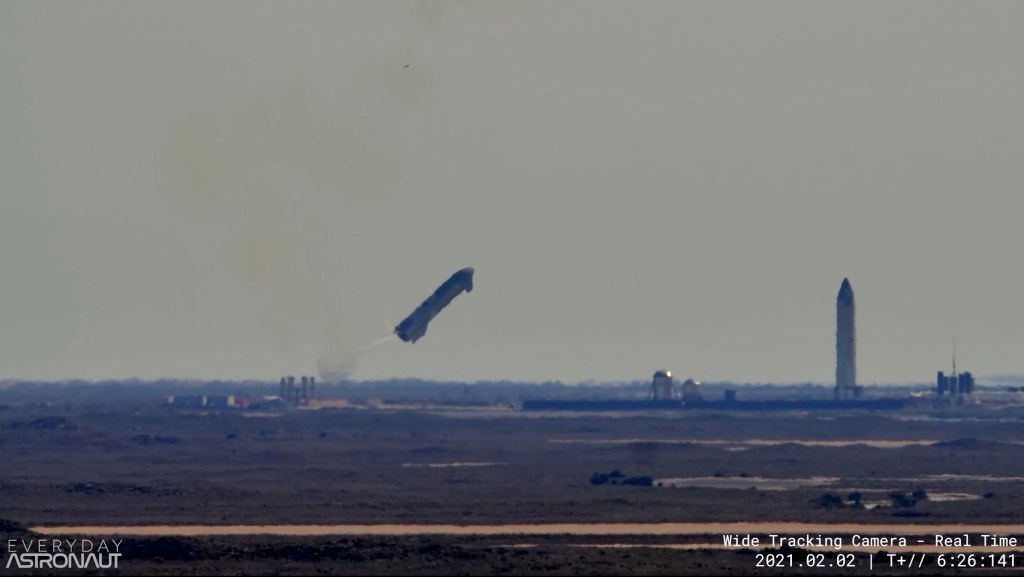
SN10
SN10 will be attempting a medium altitude test flight, like SN8 and SN9 did. It will launch from Test stand A in Boca Chica, Texas, and attempt a propulsive landing on the nearby landing pad.




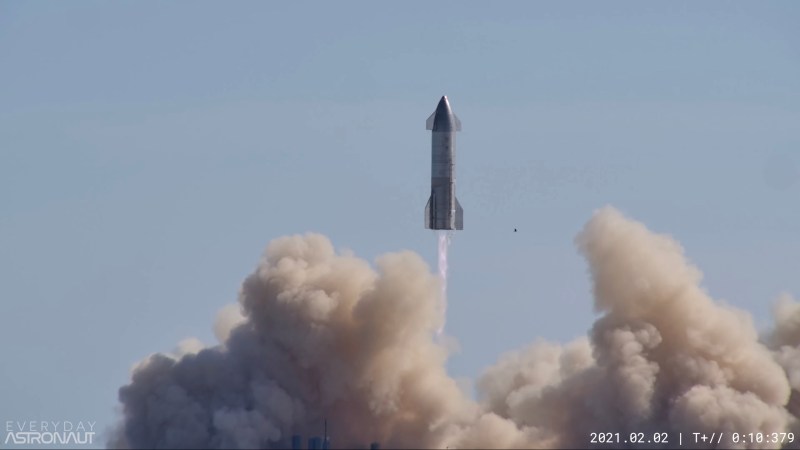
Good work, journalists! Thank you for collecting all those small facts.
Please stop. And let NASA do all the work,of the space programs and projects. You spaceX are not it. Thanks Monica zimny
Monica govt programs are a waste of money. Nasa needs to stop trying to be something they can’t be.
yeesh spacex is actually trying while nasa sits dormant barely improving SLS at all
Small correction. I quote
” Will they be attempting to recover the first stage?
Yes
Where will the first stage land?
The first stage will attempt a propulsive landing on a landing pad in Boca Chica” end quote. In fact Starships first stage is still in development, this (sn10) is a test flight for Starships second stage.
All that said, always well researched and written articles here. Thanks and keep doing the good work!
Well, yes and no, when you refer to Starship, both, the whole Starship “system” and only the second stage can be meant. In our case we refer to only the second stage when we say Starship. When it comes to the full stack we plan on clarifying that we mean the full stack. But thank you for the suggestion!
My 1 question is. With the inside of starship full of fuel and oxygen tanks along with header tanks for both. Their doesnt seem to be that much room left for a cargo bay, let alone habitation module or cockpit for crew. Am i crazy to think that? Cause i dont see any more room left.
There is actually still a lot of room for a payload. The fuel and oxidizer tanks don’t take up as much room as they seem like they should.
Here is a diagram showing the current configuration with approximate payload volume:
https://www.elonx.net/wp-content/uploads/EU5wwatXYAA4ali_Rafael_Adamy-scaled.jpg